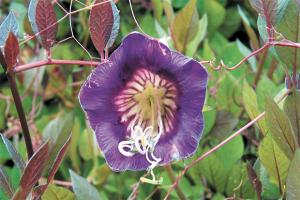Cup and Saucer Vine may be your cup of tea
Our gardens often provide us with leaves such as mints or herbs to make teas. Tea was originally served in a tea bowl, a wide, shallow bowl. This wide, shallow design has a larger surface area that lets the hot tea cool down faster.
Because tea was so expensive and exotic, tea bowls were made to purposely hold less than the more common metal cylinders used for coffee.
Tea bowls get hot and dangerous to handle, so around the 19th century tea cups with handles were invented and joined by saucers. This saucer let drinkers hold a teacup of hot tea, and the saucer was a nifty spot to hold cookies or a spoon. Eventually cup and saucer became the norm.
So it is no wonder that a real conversation plant is the aptly named Cup and Saucer Vine (Cobaea scandens) with its whimsical bell-shaped flowers that sit on their own little saucer.
The outer petals or green calyx stays flat at the base of the flower, forming the telltale saucer. The softly muted flowers begin as a pale green, but as they open they change to purple or white. Flowers are sometimes slow to appear, but once it starts blooming this vine really takes off.
Early on it will seem that all you get are leaves and long vines, but by mid- to late summer the flowers will begin to pop out and it will flower continuously until killed by frost. Oddly, the buds can have an almost unpleasant smell, but once open this changes to a pleasant, delicate honey scent.
Even when not in bloom the oblong, bright-green leaves make this a good decorative vine. Cup and Saucer Vine is hardy in USDA Hardiness Zones 9-10, so most gardeners treat it as a fast- growing annual vine.
For best blooms, always give your Cup and Saucer full sun. This fast-growing vine is ideal for covering a wall or fence. It does well in pots, but be sure to give it lots of room for its roots.
It is a good idea to weigh down the pot or secure it to a post because the weight of the vine can cause pots to tip over. This easy-care vine does well in almost any soil and isn't fussy about soil pH. Because of its fast growth it will benefit from rich organic matter mixed into the soil.
Because it is so fast-growing, you usually cannot find seedlings of Cup and Saucer Vine. It is easy to grow from seed. Plant the seeds directly in the garden after all danger of frost is past and the ground has warmed up. For quicker blooms start seeds indoors in individual peat pots. The large seeds sprout better if you soak them in lukewarm water overnight. Barely cover the seeds with soil, perhaps just a quarter-inch deep.
Germination is erratic, so be patient. To keep the fast-growing vines from getting tangled together, use a small trellis immediately.
Because young Cup and Saucer vines are sensitive to the cold, you may have to protect them from late frosts.
To keep them at manageable size, pinch out the tips of the vine. Pinching back makes for a bushier plant and increases the number of flowers. Cup and Saucer vine naturally grasps its supports with its hooked tendrils so will naturally climb without need to be tied to a trellis. Water regularly, but don't let the soil get soggy or it may rot the roots.
This rugged plant does best with no additional fertilizer. Indeed, too much fertilizer will cause it to grow lots of leaves but few flowers.
Aphids can attack young plants but are easily controlled by strong squirts of water from the hose, or use an organic insecticidal soap. Spider mites can attack, especially during hot, dry weather, and are easily treated by spraying with water and organic insecticidal soap.
For an unusual plant, try the Cup and Saucer Vine. It just may be your cup of tea.






















































